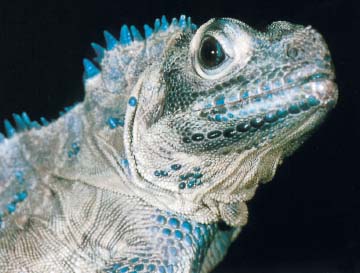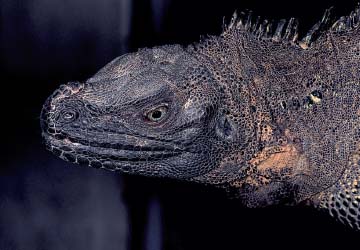
SAILFIN LIZARDS
In recent years, sailfin lizards from the Philippines have been imported into the United States with some regularity. Although offered in the pet trade, these impressive reptiles are not always a good choice for beginning herpetoculturists. Sailfin lizards grow to a large adult size and require large enclosures to remain healthy. Compared to other large lizards such as green iguanas and green water dragons, sailfin lizards tend to be shy and nervous. Adults may suddenly demonstrate wild flight behaviors and run into the sides of a vivarium. Like green water dragons, they have a limited comprehension of glass or solid barriers. Their flight behaviors can result in injured snouts and digits. Those who truly appreciate the beauty, form, and personalities of these animals and are willing to put effort into the design and maintenance of their vivaria, will find that sailfin lizards make outstanding display animals and rewarding reptile pets.

Sailfin lizards are some of the most impressive lizards in the world, but they grow very large—up to 4 feet. When young, they are very susceptible to metabolic bone disease, meaning keepers must provide supplements and, when possible, a source of UV-B light. Once established, sailfins can be prolific breeders, laying several clutches of up to ten eggs each year.
Scientific Nomenclature: The name “sailfin lizard” is used in the pet trade and refers to the large tail crest of the males of these species. The scientific name of the sailfin lizards commonly imported from the Philippines is Hydrosaurus pustulatus.
The two other species of Hydrosaurus are also occasionally imported into the United States: the soa-soa (Hydrosaurus amboinensis), from the Celebes, Moluccas, and New Guinea; and Weber’s sailfin lizard (Hydrosaurus weberi), from the Moluccas. Some researchers question the validity of these species and suggest that the Hydrosaurus may consist of only two species.
Size: Sailfin lizards are the largest members of the family Agamidae. Male soa-soa and Philippine sailfin lizards can reach a total length of 3½ feet. Females tend to be smaller than males.
Sexing: Young males can be recognized by the development of tail crest buds, which begin to appear in captive animals at about six months of age. In larger animals, the larger dorsal crests and large sailfin-like crests above the tails of males are an unmistakable characteristic. Other differentiating features include an enlarged nasal knob, usually characteristic of males (although some females will also develop these knobs), and males’ enlarged femoral and pre-anal pores.
Longevity: Sailfin lizards can live for more than ten years. One of the oldest soa-soa on record is fifteen and a half years old and still living.
Selection: When selecting a sailfin lizard, use the same process recommended for water dragons. Because sailfin lizards are kept in overcrowded conditions prior to export and when housed by U.S. dealers, parasites often spread in a given group through feces, contaminated water, and food. Sailfin lizards typically harbor several types of worms and may be infected with protozoan parasites. Ideally, have a veterinarian perform a stool check and treat the parasites (see Diseases and Disorders).
The sailfin lizard’s common name is influenced by the large tail crest in males of this species.

Sailfin lizards can grow to 4 feet long.
Housing and Maintenance
These relatively asocial lizards are best kept singly or in single pairs in large enclosures. If kept together, males will fight. Young males will bite off the ends of tails of other males. Larger animals can be quite aggressive, and weaker or subdominant animals become intimidated and stressed, and eventually die. Females also compete when kept together. For breeding purposes, keep single pairs together or keep the sexes separate and introduce the female(s) into the male’s enclosure. Possibly more than one female can be kept in a very large enclosure, but you must carefully monitor the animals for stress (typical signs include hiding, refusal to feed, and increasingly listless behavior).
Weber’s sailfin lizards have a limited range in eastern Indonesia and are only sporadically available in the general pet trade. This species has a distinctive raised fleshy nuchal crest that is clearly differentiated from the dorsal crest, which makes for lizards with a remarkable form. This species feeds readily on pink or fuzzy mice when young. As part of a varied diet, occasional mice can help reduce the risk of metabolic bone disease when raising this species from hatchlings.
The overall design of a vivarium for sailfin lizards is similar to that needed for a green water dragon, except that mature animals require enclosures at least 5 feet long, preferably larger. Provide a large water container and diagonally placed, overhanging branches. You can use large plants, such as Dracaena and Philodendron, to decorate the enclosure. Large branches, cork sections, or plants near the walls of the enclosure will reduce the incidence of damaging flight behaviors. Include a large shelter in the enclosure. Imported adults often smash their snouts against the cage sides, so it is best to purchase baby sailfins and raise them. Cover or plant heavily along the sides of an enclosure to help deter this behavior. Apart from these differences, follow the same housing and maintenance guidelines presented for green water dragons.
Diet and Water
The basic diet for sailfin lizards is similar to a water dragon diet, but they need extra plant matter. In fact, as adults, at least 50 percent of their diet should consist of vegetable matter. Sailfin lizards are omnivorous and, although juveniles tend to be primarily insectivorous, they become increasingly herbivorous as they grow older. Adults are best fed a varied diet of insects, small mice, rat pups, and vegetable matter.
Regularly offer them a “salad” of various fruits, dark green lettuces, and vegetables. They particularly enjoy sliced grapes and melons. Vegetables such as yellow squash and carrots can be offered, but should be shredded. Experts recommend a varied diet for these lizards.
Vitamin/mineral Supplementation: Use the same guidelines presented for green water dragons.
Water: Supply a large water container with a height about two-thirds the height of the animal at rest. Make sure clean water is always available.
Handling
If you want your sailfin to be somewhat tame, handle it on a regular basis. Animals that receive frequent interaction from the time they are juveniles tend to be calmer. Overall, however, sailfins are wary and nervous lizards.
Breeding
There are few records of captive sailfin breeding, in part because relatively little effort has been made in this area. The low cost of imports doesn’t justify the development of commercial breeding in the United States. The management of wild populations in the countries of origin would be a more effective and economical course of action.
The lack of large tail crest on this specimen indicates this sailfin lizard is most likely female.
When considering breeding sailfin lizards, it is important to remember that they are generally asocial and highly competitive animals. Both males and females try to achieve dominance over members of their sex. Submissive males and females in captive conditions usually show signs of stress and weight loss. If kept with dominant animals, they usually die. Therefore, the best course of action for captive breeding is either to keep single pairs together or to keep animals individually and introduce individual females to individual males after pre-breeding conditioning (similar to green water dragons). Captive-raised females reach sexual maturity at two years and eventually lay eggs at least once a year. Pre-breeding conditioning is recommended in early winter. Breeding occurs in late winter or early spring, and egg-laying follows in mid to late spring.
When rearing juveniles, use the guidelines presented for green water dragons. Provide an easily accessible shallow pan of water and mist the juveniles daily. The initial diet should consist of supplemented two-week-old crickets. At about three weeks, offer some finely chopped fruits and vegetables. By the age of three months, properly maintained animals will begin to accept pink mice. Segregate the animals at a young age.
Number of Eggs: Females lay eight to ten eggs, possibly more in larger animals.
Incubation: Use the same techniques listed for green water dragons. Incubate eggs at about 82–85° F.
Economic Herpetoculture
Large numbers of sailfin lizards are hunted for food in their native countries. In the Philippines, there is now collecting pressure on both adults (for food) and juveniles (for the pet trade). Unless the wild populations are managed through some type of wildlife agency, at least two of the three species could become threatened.
These species should be recognized as economic resources and effective management programs should be implemented to allow for sustained harvesting without threatening the status of existing populations. A combination of population management in the field combined with more controlled herpetoculture could be effective. Directions for management could include:
• Establishing a hunting/collecting season that would prevent collection or hunting of animals during the entire reproductive season.

This is a healthy example of a juvenile Philippine sailfin lizard.
Male Philippine sailfin lizards can reach more than 3½ feet in total length.
• Setting collection limits during the collecting/hunting season, at least on adults.
• Encouraging the development of the economic herpetoculture of these species.